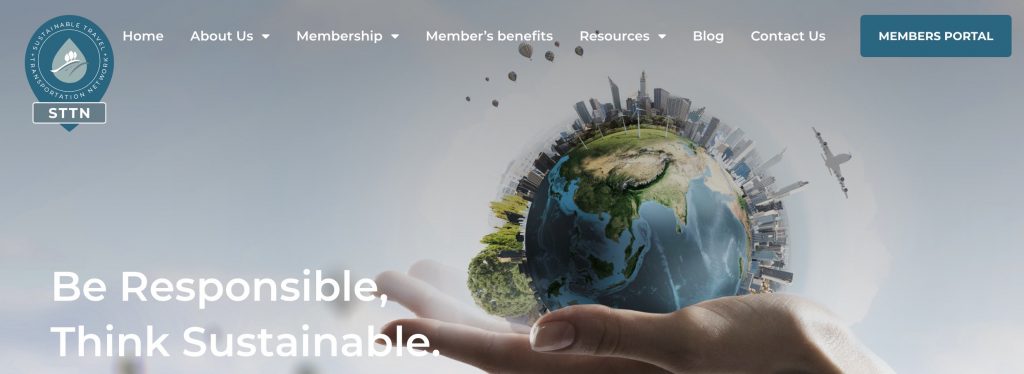
Sustainable Travel & Transportation Network was launched on April 24, offering a community-based marketplace that provides a platform for users to meet carbon emissions targets and find travel partners committed to sustainable operations and services. STTN provides comprehensive resources for companies to create sustainable travel supply chains. The company provides training, resources, and opportunities for participating members to build greater efficiencies, better-managed procurement processes, and the ability to integrate sustainability as a core business value and goal in the travel, transportation, and tourism sectors. STTN works from a comprehensive vision of what sustainability means for network members — environmental, social, and economic factors that are expected to be reached by stakeholders including customers, board members, shareholders, and governing bodies.
The company’s co-founders are Sara Richardson, previously the founder and president of non-profit business development association RAS International; and Patricia Charla, previous co-founder for environmental certification and consultancy Tech360. Faculty for training programs include sustainable travel consultancy TravelHorst founder Horst Bayer and IGManagement managing director Bernard Harrop; sustainability software GreenFeet founder Lisa McKelvey is also part of the company’s leadership team.
STTN is designed for corporate travel managers, travel management companies and travel agencies, accommodation and destination service providers, sustainability officers, transportation service providers, and other service providers and supporters, to meet environmental, social and governance (ESG) goals through efficient, achievable, and durable practices. Participating members will be guided and supported in how to achieve STTN certification, which complies with carbon offsets that must be measurable, monitored over time, and validated by an independent third party, the United Nations (UN), or a government body. For more information, visit the website at www.sttnetwork.com.
Details on the new EPA proposed vehicle emissions standards: What’s distinct about the new proposed set of emissions guidelines for passenger and commercial vehicles announced this month by EPA administrator Michael Regan? By 2032 about two-thirds of new passenger vehicles will have to be zero emissions — which mean battery- and fuel cell-powered vehicles. Internal analysis found that with nearly 70 percent EVs sold by 2032 and about 40 percent in medium-duity vehicles would be a pathway for successfully complying, Medum-duty breaks out to vehicles in the 8,501 to 14,000 pound range. It can also be heavy-duty vehicles such as semi trucks, tractors, buses, cherry pickers, and delivery vans. The end goal is to reduce close to 10 billion metric tons of carbon-dioxide emissions.
There are currently loopholes in the EPA first draft that favor SUVs and crossovers, which have been very popular in US new vehicles sales — up there with pickup trucks. Overall, the federal government and lawmakers face that age-old question: If you build it, will they come? Will car shoppers be buying them? EVs tend to be more expensive than their gasoline-powered equivalents, and with interest rates going up, it’s getting more costly to borrow money to buy a new car or truck.
Climate Investments: For those interested in tapping into California’s vast financial resources supporting clean transportation, you might want to attend California Air Resources Board’s (CARB’s) virtual public workshop on funding guidelines for agencies that administer California Climate Investments. California Climate Investments implemented nearly 19,500 new projects through $1.3 billion in funding in 2022 alone, with $933 million directly benefiting disadvantaged communities and low‑income communities and households, according to the state. This workshop takes place May 8, 2023, at 2:00 pm PST.
Renewable NG tax credit introduced: Rep. Linda T. Sánchez, D-Calif., and Rep. Brian Fitzpatrick, R-Pa., earlier this month introduced the Renewable Natural Gas Incentive Act, which would provide a tax credit for renewable natural gas that is used in heavy-duty vehicles in order to immediately reduce greenhouse gas and particulate emissions while further supporting clean and efficient transportation across the country. “This tax credit will allow transit agencies, school districts, freight haulers and package delivery companies to replace aging fleets with sustainable alternatives, all without slowing production or increasing costs,” Sánchez said.
ACT Expo just around the corner: John O’Leary, president and CEO of Daimler Truck North America (DTNA) will be the opening keynote speaker at the 12th annual ACT Expo, May 1-4, 2023, at the Anaheim Convention Center in Southern California. DTNA is North America’s largest manufacturer of Class 5-8 commercial vehicles and aims to offer an exclusively CO2-neutral new vehicle product line by 2039.
O’Leary’s keynote on Monday, May 1, will be followed by the debut of the 2023 State of Sustainable Fleets market brief report, which will highlight key trends and the ever-increasing clean vehicle adoption plans of fleets across the nation. Learn more about media events to hear about breaking industry news and to witness new product reveals and vehicle unveilings.

 the plant’s construction, with the nickname of GiGA4Berlin. Tesla continues to work quickly through the COVID-19 crisis and inner turmoil over management turnovers. One theory is that CEO Elon Musk and team are learning big lessons from crafting two vehicle plants and one battery factory to produce four models to production scale (with the fifth, the Model Y,
the plant’s construction, with the nickname of GiGA4Berlin. Tesla continues to work quickly through the COVID-19 crisis and inner turmoil over management turnovers. One theory is that CEO Elon Musk and team are learning big lessons from crafting two vehicle plants and one battery factory to produce four models to production scale (with the fifth, the Model Y, 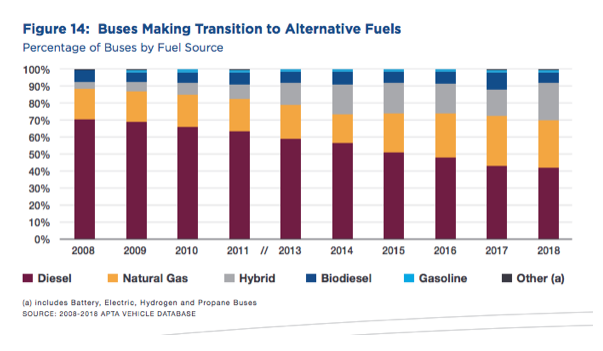
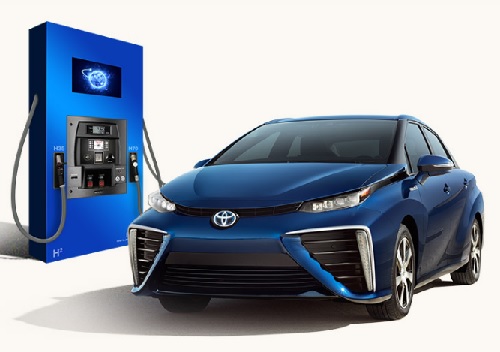 Co., that concludes there are now three core market drivers: a steep drop in production costs, higher load utilization cutting distribution and refueling costs, and additional cost drops from scaling up of end-use equipment manufacturing. The study looked at 25,000 data points gathered and analyzed from 30 global companies with cost reductions expected across several different hydrogen applications. These sectors include long-distance and heavy-duty transportation, industrial heating, heavy industry feedstock, and others, which make up about 15 percent of global energy consumption. Of course, much support is needed and Hydrogen Council is championing effective government policies to be adopted in key geographies, along with investment support of around $70 billion in the lead up to 2030 in order to scale up and produce for a much more cost-competitive fuel. “The Hydrogen Council believes that the report’s findings will not only increase public awareness about the potential of hydrogen to power everyday lives, but also debunk the myth that a hydrogen economy is unattainable due to cost,” said Euisun Chung, executive vice chairman of Hyundai Motor Group and co-chair of the Hydrogen Council. “If we are to reach our global climate goals by mid-century and reap the benefits of hydrogen, now is the time to act.”
Co., that concludes there are now three core market drivers: a steep drop in production costs, higher load utilization cutting distribution and refueling costs, and additional cost drops from scaling up of end-use equipment manufacturing. The study looked at 25,000 data points gathered and analyzed from 30 global companies with cost reductions expected across several different hydrogen applications. These sectors include long-distance and heavy-duty transportation, industrial heating, heavy industry feedstock, and others, which make up about 15 percent of global energy consumption. Of course, much support is needed and Hydrogen Council is championing effective government policies to be adopted in key geographies, along with investment support of around $70 billion in the lead up to 2030 in order to scale up and produce for a much more cost-competitive fuel. “The Hydrogen Council believes that the report’s findings will not only increase public awareness about the potential of hydrogen to power everyday lives, but also debunk the myth that a hydrogen economy is unattainable due to cost,” said Euisun Chung, executive vice chairman of Hyundai Motor Group and co-chair of the Hydrogen Council. “If we are to reach our global climate goals by mid-century and reap the benefits of hydrogen, now is the time to act.”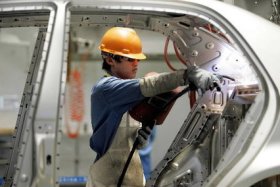 coming close to a record high in the U.S. (which surprised market analysts), that may be a temporary blip. Foreign automakers have 19 assembly plants in the U.S., but General Motors is closing four American plants and Ford is going through a major reorganization. Even so, U.S. auto plants have the capacity to make three million more cars that they can sell. Analysts think that this year’s strong sales come from higher fleet sales, lower unemployment, and Tesla’s rapid production ramp up. Shareholders are putting a great deal of pressure on automakers to lead the way in new products, advanced vehicle technology, and strong profit margins. Automakers have been taking big steps to change over their product lineups (less cars, more trucks and SUVs) and prepare for launching mobility services and a higher volume of electric vehicles. Here’s a look at some of the major events that have been shaping market dynamics in the U.S. and global automotive landscape — and its impact on green vehicle sales and adoption of new technology and mobility………….
coming close to a record high in the U.S. (which surprised market analysts), that may be a temporary blip. Foreign automakers have 19 assembly plants in the U.S., but General Motors is closing four American plants and Ford is going through a major reorganization. Even so, U.S. auto plants have the capacity to make three million more cars that they can sell. Analysts think that this year’s strong sales come from higher fleet sales, lower unemployment, and Tesla’s rapid production ramp up. Shareholders are putting a great deal of pressure on automakers to lead the way in new products, advanced vehicle technology, and strong profit margins. Automakers have been taking big steps to change over their product lineups (less cars, more trucks and SUVs) and prepare for launching mobility services and a higher volume of electric vehicles. Here’s a look at some of the major events that have been shaping market dynamics in the U.S. and global automotive landscape — and its impact on green vehicle sales and adoption of new technology and mobility………….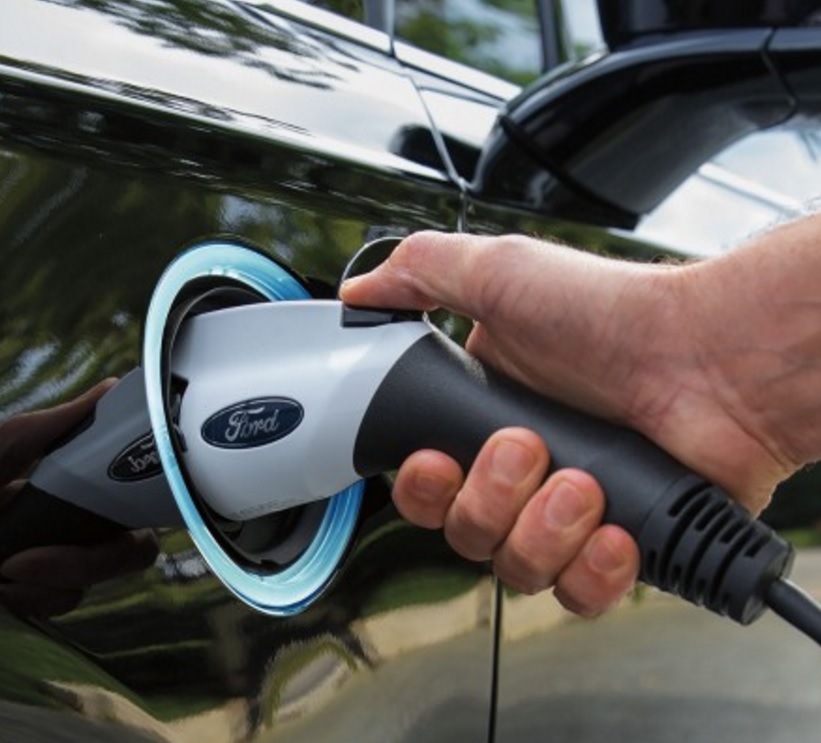 with 50 new Ford and Lincoln models going to that market by 2025. There will be at last 15 new electric vehicles under these brands, and the separate Zotye-Ford joint venture will offer a range of affordable all-electric vehicles under a new brand. Sport utility vehicles will be emphasized, with eight new utility vehicles being rolled out under the 50-vehicle launch. Connectivity will play a greater role, with all Ford and Lincoln vehicles in China connected through either embedded modems or plug-in devices by the end of 2019. As for autonomous vehicles, Ford will tap into its board member presence of Chinese company Baidu’s Project Apollo. The Apollo Open Platform will facilitate the development, testing, and deployment of autonomous vehicles, the company said………… Electric bus manufacturer Proterra announced yesterday that Yosemite National Park will add two Proterra Catalyst buses to its fleet. It will be the first U.S. National Park to permanently add zero-emission buses to its shuttle fleet, offering its visitors a modern, ecologically-friendly transportation option, Proterra said. Beginning service in late 2018, the Catalyst buses are expected annually to reduce 887,000 lbs. of greenhouse gas emissions and save approximately $150,500 on maintenance and operating costs for the national park………… Volkswagen AG’s Moia mobility service division yesterday
with 50 new Ford and Lincoln models going to that market by 2025. There will be at last 15 new electric vehicles under these brands, and the separate Zotye-Ford joint venture will offer a range of affordable all-electric vehicles under a new brand. Sport utility vehicles will be emphasized, with eight new utility vehicles being rolled out under the 50-vehicle launch. Connectivity will play a greater role, with all Ford and Lincoln vehicles in China connected through either embedded modems or plug-in devices by the end of 2019. As for autonomous vehicles, Ford will tap into its board member presence of Chinese company Baidu’s Project Apollo. The Apollo Open Platform will facilitate the development, testing, and deployment of autonomous vehicles, the company said………… Electric bus manufacturer Proterra announced yesterday that Yosemite National Park will add two Proterra Catalyst buses to its fleet. It will be the first U.S. National Park to permanently add zero-emission buses to its shuttle fleet, offering its visitors a modern, ecologically-friendly transportation option, Proterra said. Beginning service in late 2018, the Catalyst buses are expected annually to reduce 887,000 lbs. of greenhouse gas emissions and save approximately $150,500 on maintenance and operating costs for the national park………… Volkswagen AG’s Moia mobility service division yesterday  Thursday on the
Thursday on the  dialogue on the midterm review and beyond. Former EPA official Margo Oge sees Ford, a longtime environmental advocate, well suited to help California, the federal government, and automakers negotiate any flexibility needed through 2025 and to set a road map for 2030. Automakers had been able to have the Trump administration reopen the 2022-2025 midterm review after it had been approved right before the end of the Obama administration. The former EPA official sees it as a win-win for Ford’s stock price and for resolving a difficult issue. “I believe if he does that, we will see the investor community respond with a stock price increase in Ford because investors are looking for companies that are not behaving like the traditional OEMs with competition from Silicon Valley, Tesla and China,” Oge said.
dialogue on the midterm review and beyond. Former EPA official Margo Oge sees Ford, a longtime environmental advocate, well suited to help California, the federal government, and automakers negotiate any flexibility needed through 2025 and to set a road map for 2030. Automakers had been able to have the Trump administration reopen the 2022-2025 midterm review after it had been approved right before the end of the Obama administration. The former EPA official sees it as a win-win for Ford’s stock price and for resolving a difficult issue. “I believe if he does that, we will see the investor community respond with a stock price increase in Ford because investors are looking for companies that are not behaving like the traditional OEMs with competition from Silicon Valley, Tesla and China,” Oge said.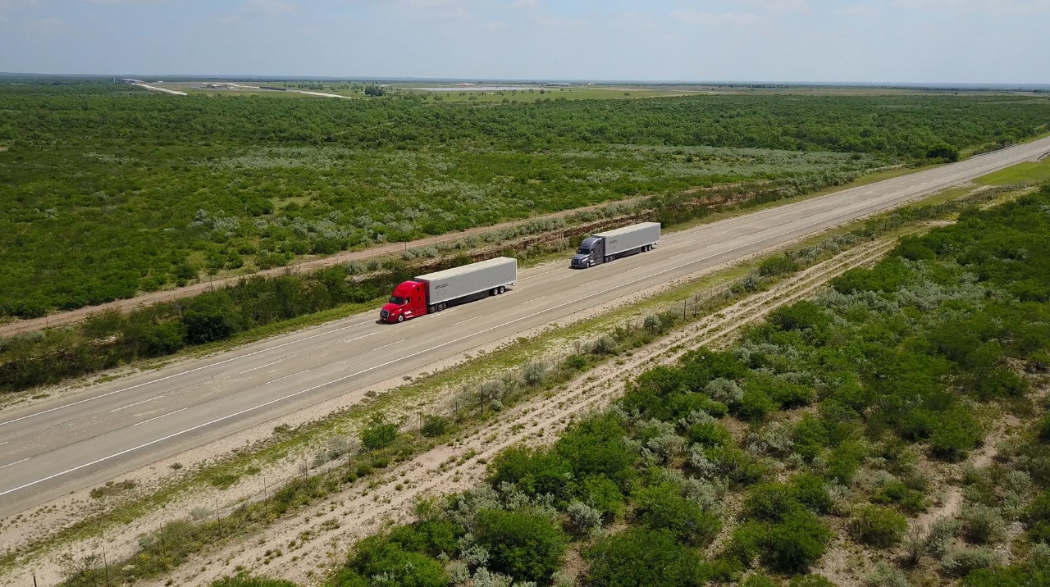 two trucks travel in tandem at distances closer than what is possible under normal driving conditions; as you can see in the photo. Daimler Truck engineers are overseeing a pilot project on Oregon and Nevada highways in cooperation with state officials. The company is also testing braking on a closed track at its High Desert Proving Grounds in Madras, Ore. Daimler Trucks is getting ready for a fleet trial early next year. “Platooning holds the potential to offer significant fuel economy advantages, while assisting drivers,” said Roger Nielsen, president and CEO, DTNA. “To be sure, the platooning technology is not meant to replace drivers – it’s designed to help drivers.”
two trucks travel in tandem at distances closer than what is possible under normal driving conditions; as you can see in the photo. Daimler Truck engineers are overseeing a pilot project on Oregon and Nevada highways in cooperation with state officials. The company is also testing braking on a closed track at its High Desert Proving Grounds in Madras, Ore. Daimler Trucks is getting ready for a fleet trial early next year. “Platooning holds the potential to offer significant fuel economy advantages, while assisting drivers,” said Roger Nielsen, president and CEO, DTNA. “To be sure, the platooning technology is not meant to replace drivers – it’s designed to help drivers.” 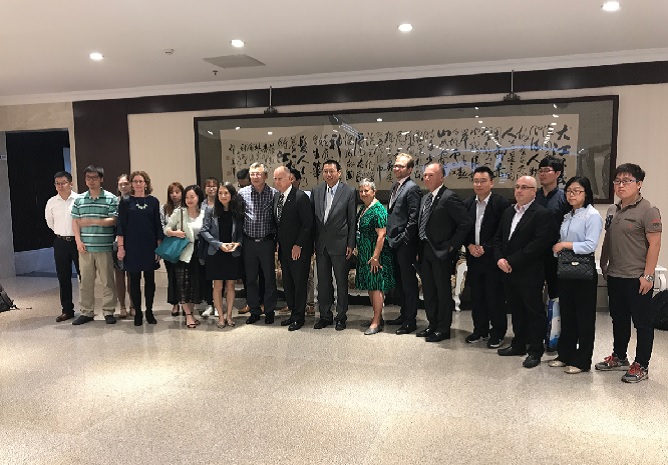 away from the Paris climate change accord. Governor Jerry Brown and California Air Resources Board chair Mary Nichols met with officials from China’s leading automakers and battery manufacturers this week in an effort to expand cooperation and accelerate deployment of zero-emission cars, trucks, and buses. A new working group was formed through the China-US ZEV Policy Lab at UC Davis to expand cooperation with Chinese vehicle and batter makers. The lab comes from a partnership established in 2014 between UC Davis Institute of Transportation Studies and the China Automotive Technology and Research Center. Brown and Nichols have been touring China this week as the nation prepares to adopt the state’s ZEV policy with credits for automakers to purchase and trade for meeting emissions rules.
away from the Paris climate change accord. Governor Jerry Brown and California Air Resources Board chair Mary Nichols met with officials from China’s leading automakers and battery manufacturers this week in an effort to expand cooperation and accelerate deployment of zero-emission cars, trucks, and buses. A new working group was formed through the China-US ZEV Policy Lab at UC Davis to expand cooperation with Chinese vehicle and batter makers. The lab comes from a partnership established in 2014 between UC Davis Institute of Transportation Studies and the China Automotive Technology and Research Center. Brown and Nichols have been touring China this week as the nation prepares to adopt the state’s ZEV policy with credits for automakers to purchase and trade for meeting emissions rules. certified to the optional low nitrogen oxide (NOx) level .05 g/bhp-hr. These new U.S. Environmental Protection Agency- and California Air Resources Board-certified propane engines are 75% cleaner than the current emissions standard. “Roush CleanTech’s low NOx engine is a great step forward for the propane industry,” said Tucker Perkins, president of the Propane Education & Research Council. “Propane autogas is well established as an economical, clean-burning and domestically produced alternative fuel ideal for fleets. Now propane gets the biggest return on NOx reductions, too.”
certified to the optional low nitrogen oxide (NOx) level .05 g/bhp-hr. These new U.S. Environmental Protection Agency- and California Air Resources Board-certified propane engines are 75% cleaner than the current emissions standard. “Roush CleanTech’s low NOx engine is a great step forward for the propane industry,” said Tucker Perkins, president of the Propane Education & Research Council. “Propane autogas is well established as an economical, clean-burning and domestically produced alternative fuel ideal for fleets. Now propane gets the biggest return on NOx reductions, too.” 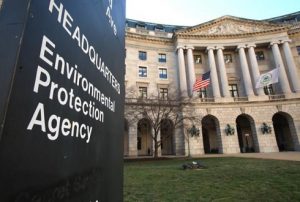 EPA opponent appointed: President-elect Donald Trump hit hard last week in his Environmental Protection Agency appointment – naming Oklahoma Attorney General Scott Pruitt as administrator, which will need to meet Senate approval.
EPA opponent appointed: President-elect Donald Trump hit hard last week in his Environmental Protection Agency appointment – naming Oklahoma Attorney General Scott Pruitt as administrator, which will need to meet Senate approval. 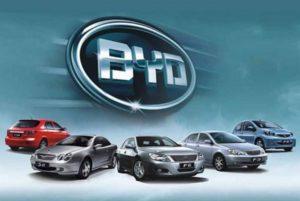 China-based plug-in electrified vehicle manufacturer BYD has become
China-based plug-in electrified vehicle manufacturer BYD has become